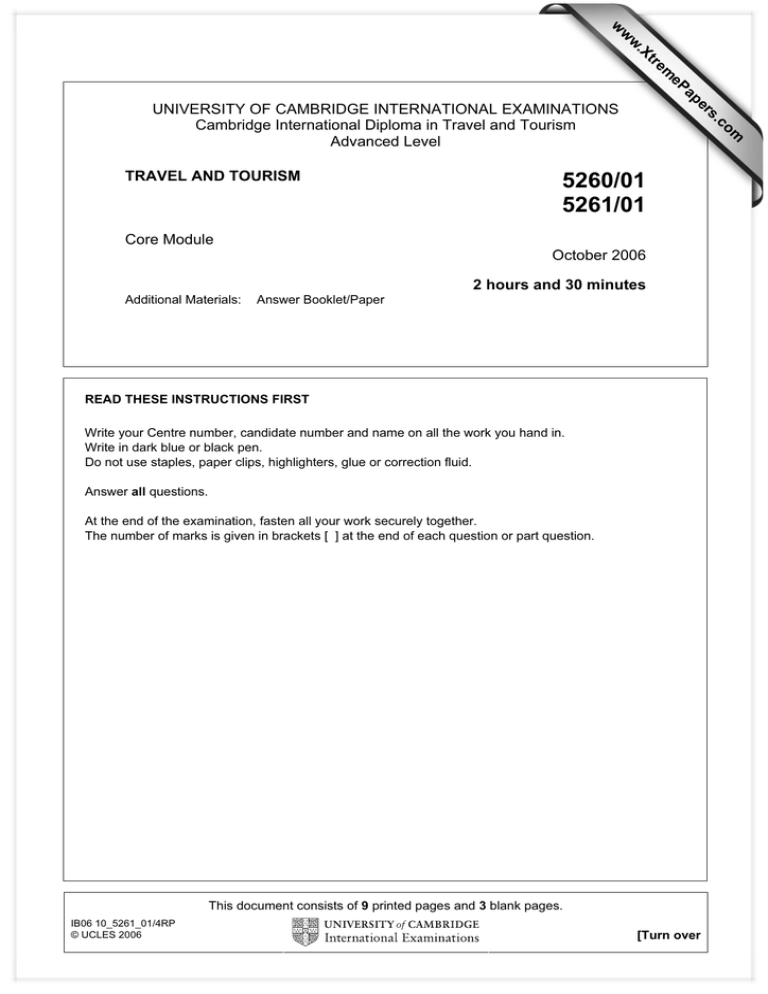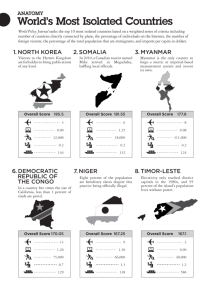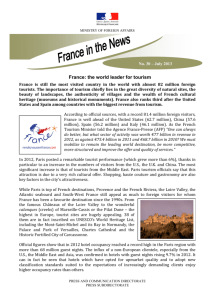www.XtremePapers.com
advertisement

w w ap eP m e tr .X w om .c TRAVEL AND TOURISM s er UNIVERSITY OF CAMBRIDGE INTERNATIONAL EXAMINATIONS Cambridge International Diploma in Travel and Tourism Advanced Level 5260/01 5261/01 Core Module October 2006 2 hours and 30 minutes Additional Materials: Answer Booklet/Paper READ THESE INSTRUCTIONS FIRST Write your Centre number, candidate number and name on all the work you hand in. Write in dark blue or black pen. Do not use staples, paper clips, highlighters, glue or correction fluid. Answer all questions. At the end of the examination, fasten all your work securely together. The number of marks is given in brackets [ ] at the end of each question or part question. This document consists of 9 printed pages and 3 blank pages. IB06 10_5261_01/4RP © UCLES 2006 [Turn over 2 Question 1 China’s tourism development China’s continuing economic reforms since 1978 have substantially altered its economic structure, expanding the service sector, including the tourist industry. The reforms have resulted in spectacular economic growth and a boom in tourism development. China has abundant resources for tourism, which provide an advantage for developing tourism. “In 1992, which marked the first Visit China Year, the country received barely 15 million foreign tourists but, just a decade after, the figure was 37 million,” said the secretary-general of WTO. The trend will continue and according to the WTO’s prediction, China will become the world’s number one tourism destination in 2020, overtaking many other countries. China will not only introduce fierce competition for visitors, but also unprecedented opportunities. China’s rising tourism will create chances for hotels, aviation and travel agencies. The biggest travel agencies in Europe and the world’s biggest aircraft manufacturer find business in China. Jalpak International plan to open its first solely foreign-funded travel agency in China. The first foreign capital controlled travel agency will also operate soon. Experts say the entry of international travel agencies indicates China’s strong attraction. By 2004, China’s tourism utilised 50 billion US dollars of foreign capital, accounting for 11 per cent of all business foreign capital utilisation. China’s world destination status puts some other nations under pressure, while China’s growth in outbound tourists cheer them up. Over 16.6 million Chinese travellers went abroad last year, making China a fast growing tourism source nation in the Asia and Pacific region. China is poised to become one of the top-generating markets for the rest of the world. The WTO’s intelligence services have been informed that several delegations intend to take advantage of this to strengthen their commercial positions in the Chinese market. China’s 5000 years of tumultuous history place it, without doubt, among the world’s greatest travel destinations - The Great Wall, Xi’an’s Terracotta Army, the Forbidden Palace and Tian’anmen Square; the very names reveberate with history and legend. China’s vast scenic beauty includes the gorges of the Yangtze river, and the dramatic mountain ranges of the northern Tibetan plateau only add to its attraction. A destination steeped in history, culture and natural wonders, China offers a truly wonderful experience. Temple of Heaven, Beijing Fig. 1a © UCLES 2006 5261/01/O/06 3 Read the articles in Figs 1a and 1b, giving information on China as a tourist destination. Using your own knowledge of tourism development together with information from the articles, answer the following questions. (a) Describe two major economic advantages to China if it became 'the world's number one tourist destination in 2020'. [4] (b) China's developing tourism will create opportunities for commercial operators. Explain how each of the following will benefit China: (i) foreign-funded travel agencies [3] (ii) foreign-funded hotel chains. [3] (c) Explain two reasons why other tourist destinations in the Asia and Pacific regions were pleased that there were over 16.6 million outbound Chinese travellers. [6] (d) Analyse the importance of tourism training to countries such as China, which are developing tourism. [6] Great Wall of China The Great Wall of China, one of the greatest wonders of the world, was enlisted in the World Heritage by UNESCO in 1987. Just like a gigantic dragon, the Great Wall winds up and down across deserts, grasslands, mountains and plateaus stretching approximately 6700 kilometres (4163 miles) from the east to the west of China. With a history of more than 2000 years, some of the sections of the Great Wall are now in ruins or even entirely disappeared. However, it is still one of the most appealing attractions around the world owing to its architectural grandeur and historical significance. Swarms of foreign tourists have come to see this ancient Chinese wonder with the result that it has become fashionable to walk along the Wall. The current problem is to strike a balance between the need to protect our cultural heritage and the economic benefit it brings through tourism to the country. However, many questions remain unanswered with regard to preservation and the development of tourism. Clearly, steps have to be taken to preserve the Wall in a manner that does not detract from its cultural importance while keeping it in good condition for the benefit of future generations. BEIJING Great Wall XIAN SHANGHAI Chongqing Wuhan Yangtze River CHINA Hong Kong Hanoi Chiang Mai THAILAND Kwai Bangkok The Great Wall of China Fig. 1b (e) Refer to Fig. 1b. Discuss the environmental and cultural measures that may be necessary to protect the Great Wall of China for future generations of visitors. [8] [Total : 30] © UCLES 2006 5261/01/O/06 [Turn over 4 Question 2 Fig. 2a SAMPLE DISCOUNT VOUCHERS Fig. 2b © UCLES 2006 5261/01/O/06 5 Singapore set to train 400 agents SINGAPORE is to launch its first formal training scheme for agents this summer. The online programme, to be unveiled in the next few weeks, will have its own website featuring self-study modules. Singapore Tourism Board hopes between 300 and 400 agents will sign up for the project by the end of this year. “Initially we will be looking to work through operators by getting them to nominate agents for the scheme,” said the Board’s Northern and Western Europe Director, Tee Yen Chew. “We are also talking to a couple of operators about offering booking incentives to agents who join the programme,” she added. The project’s working title is the Singapore Specialist Programme, but a final name has yet to be decided. A similar scheme has already been launched in Germany. “That has gone very well - we have been delighted with the response,” said Chew. Training has previously been restricted to an on-request basis and has been run in conjunction with operators. “But we realise that agents’ knowledge of the destination can be improved,” admitted Chew. “Some think there is nothing much to do in Singapore - that is where we have to prove them wrong.” The training programme coincides with the launch of the destination’s £1 million marketing campaign under the banner “Uniquely Singapore”. This tagline is to feature heavily in a major advertising campaign starting this autumn and there will be an emphasis on joint promotions with operators. Fig. 2c Read the information in Figs 2a, 2b and 2c, giving information on Singapore. Using your own knowledge of marketing and promotion, together with information from the article, answer the following questions. (a) Refer to Figs 2a and 2b. The Singapore Tourist Board offers discount vouchers to tourists on 'stopover holidays' for a range of visitor attractions in Singapore. Describe one advantage and one disadvantage of this type of marketing communication method. [4] (b) The Singapore Stopover Holiday Guide advertises a number of private and public sector organisations. Explain two advantages of this partnership using marketing principles. [6] (c) Questionnaires and surveys often give participants a free gift or entry into a prize draw. Explain the reason for such actions. [2] (d) Describe three 'above the line' marketing communication methods the Singapore Tourist Board could use to advertise to consumers. [6] (e) The Singapore Tourist Board plans to train 400 agents. Discuss the effectiveness of this method of public relations. [6] [Total : 24] © UCLES 2006 5261/01/O/06 [Turn over 6 Question 3 Malta Follow in the footsteps of the Phoenicians, Greeks and Romans and spend some time in this welcoming Mediterranean island. Malta has a gentle landscape of low green hills sloping down to a coastline that varies between wide, sandy bays and rocky coves. You’ll find almost every watersport from windsurfing to paragliding, water-skiiing or fishing. Scuba-diving is particularly good, even for beginners. If nightlife is high on your agenda, try St Julian’s which has plenty to offer, with lively bars, nightclubs and a casino. Quayside restaurants overlook a harbour where traditional-coloured boats offer perfect photo opportunities and you’ll find pizza and fast food as readily available as Maltese favourites such as rabbit cooked in wine. For traditional entertainment, join in with the local village ‘festas’ that take place all over the island in summer. Malta is steeped in history and you really should visit Valletta, the fortified city built in the 16th-century by the Knights of St John. The ancient city of Mdina dates back some 4000 years and is another interesting day out. If all this sounds a little too strenuous, refresh yourself with a boat trip to the sleepy islands of Gozo or Comino. Lively St Julian’s has many five-star hotels and is popular with younger people. Tourism in Malta started in the late 1950’s when the government set upon a programme of improving access to beaches and the creation of the Malta Government Tourist Board. Demand continued to increase, prices rose but quality fell. The then current Maltese infrastructure could not take this scenario with the result that massive infrastructural problems, such as water shortage problems, began to arise. Measures were taken to combat this decline. These included: • Diversification into new continental markets; new tourist offices were opened in Frankfurt, Paris, Amsterdam, Milan and, recently, in New York; • further additions to the accommodation sector were halted; • a major reclassification exercise for all hotels; • new permits only given to 5* or 4* hotels; • setting up an Institute for Tourism Studies; • commitment towards the setting-up of excellent conference facilities; • general infrastructural developments such as improved water supply and brand new distribution network. Malta is becoming more accessible. The islands are connected to 48 countries through chartered and scheduled flights. Malta’s tourist profile has changed from one which was mainly focused on visiting friends and relatives to a much more diverse purpose of visit. Malta has been transformed into a destination which has the potential to offer something for everyone. Malta attracts 1% of total tourists to the Mediterranean. It is being marketed not solely as a destination for one’s main annual summer holiday, but even more so as an off-peak destination. Particular niche markets have been developed. These include the meetings, incentives, conferences and exhibitions market, plus diving and other water sports. The aim of this line of tourism development has been to enhance what Malta offers in order to make the country more attractive as a tourism destination and thus earn further foreign earnings from the more lucrative source markets. Fig. 3a © UCLES 2006 5261/01/O/06 7 Ramla Bay M G O Z O Cittadella Azure Window ed it er ra COMINO n e Blue Lagoon n S M Mellieha Bay St Paul’s Bay Popeye Village e d e it r r a n Valletta e n S e a e a St Julians Sliema Golden Bay a 0 a Mediterranean Film Studios M A L T A Mdina 5 miles Fig. 3b Read the article in Fig. 3a and study Fig 3b, giving information on Malta as a tourist destination. Using your own knowledge of tourism development together with information from Figs 3a and 3b, answer the following questions. (a) Malta is a desirable tourist destination. Identify four factors that may account for its popularity. [4] (b) Malta is a destination rich in history and the city of Mdina dates back 4000 years. Explain two reasons why history and culture are important to destinations such as Malta. [4] (c) Using only Fig. 3a, explain two ways in which Malta’s tourist infrastructure has benefited from the methods used to stop the decline of tourism. [4] (d) Describe three measures that have been taken in Malta to sustain successful destination management. [6] (e) The public, private and voluntary sectors play an important part in destination management. Discuss how the partnership between these sectors benefits destinations such as Malta. [8] [Total : 26] © UCLES 2006 5261/01/O/06 [Turn over 8 Question 4 New EU 10 may get tourist boost The European Union’s 10 newest members may receive a huge economic boost by maximising their appeal to tourists. The nations, which joined the EU on 1 May 2004, could earn 46bn euro (£31bn;$57bn) by 2010 if they attract more visitors, an industry report has said. Poland and Hungary are set to be the main beneficiaries, with the potential to create more than 2 million jobs during the next six years. Prague remains one of Europe’s most popular cities The EU earned 1.1 trillion euros from tourism last year, 8% of its total GDP. Dramatic benefits According to a new report by the World Travel and Tourism Council (WTTC), the ‘gang of ten’ countries could enjoy dramatic economic benefits by investing in tourism related infrastructures and technology. By 2010, as many as 3 million tourism-related jobs could be created across Cyprus, the Czech Republic, Estonia, Hungary, Latvia, Lithuania, Malta, Poland, Slovakia and Slovenia, the respected tourism organisation has claimed. Tourism could also act as a much-needed catalyst, boosting the economies of countries such as Poland and Hungary where traditional industries such as manufacturing and agriculture have collapsed. Entrepreneurial Activity The new member states bring with them a wealth of new resources, particularly in terms of their rich cultural heritage, their landscapes and natural reserves. Government bodies must work with the private sector to promote cross-border investment, improve skills training and sustain the natural environment. Fig. 4 © UCLES 2006 5261/01/O/06 9 Refer to Fig. 4. (a) The EU (European Union) earned 8% of its total GDP from tourism. Briefly explain the meaning of this statement. [2] (b) Outline two reasons why the economic impacts of tourism are more noticeable in developing countries. [4] (c) Outline two reasons why the absence of border controls in the ten new EU countries may contribute to increased visitor numbers. [4] (d) Many countries in the EU are rich in 'landscapes and natural reserves'. Explain two reasons for the importance of sustaining the natural environment. [4] (e) Discuss the methods which destinations such as Poland and Hungary may use to promote successful destination management. [6] [Total : 20] © UCLES 2006 5261/01/O/06 [Turn over 10 BLANK PAGE 5261/01/O/06 11 BLANK PAGE 5261/01/O/06 [Turn over 12 BLANK PAGE Copyright Acknowledgements: Question 1 Question 1 Question 2 Question 2 Question 2 Question 3 Question 4 Fig. 1a © www.chinadaily.com.cn Fig. 1b © www.travelchinaguide.com Fig. 2a © Singapore Airlines. Fig. 2b © Singapore Airlines. Fig. 2c © Travel Trade Gazette, 1 April 2002. Fig. 3a © www.visitmalta.com Text courtesy of the Malta Tourism Authority. Fig. 4 © www.bbc.co.uk 17 November 2004. Permission to reproduce items where third-party owned material protected by copyright is included has been sought and cleared where possible. Every reasonable effort has been made by the publisher (UCLES) to trace copyright holders, but if any items requiring clearance have unwittingly been included, the publisher will be pleased to make amends at the earliest possible opportunity. University of Cambridge International Examinations is part of the University of Cambridge Local Examinations Syndicate (UCLES), which is itself a department of the University of Cambridge. 5261/01/O/06







